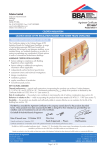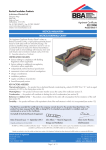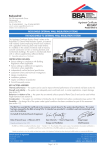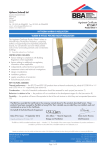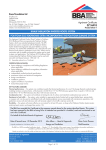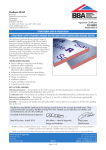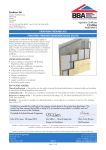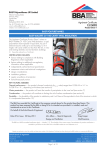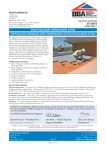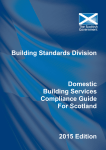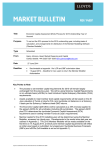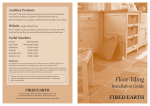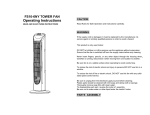Download BBA Certificate
Transcript
APPROVAL INSPECTION TESTING CERTIFICATION Rockwool Ltd 26/28 Hammersmith Grove Hammersmith London W6 7HA Tel: 01656 862621 Fax: 01656 862302 TECHNICAL APPROVALS FOR CONSTRUCTION Agrément Certificate 10/4796 e-mail: [email protected] website: www.rockwool.co.uk Product Sheet 1 ROCKWOOL BLOWING-IN GRANULATE INSULATION ROCKWOOL ROCKPRIME BLOWN LOFT INSULATION This Agrément Certificate Product Sheet(1) relates to Rockwool Rockprime Blown Loft Insulation, stone wool fibres for use as insulation in-between and above the joists at ceiling level in ventilated pitched roofs of dwellings or buildings of similar occupancy. (1) Hereinafter referred to as ‘Certificate’. CERTIFICATION INCLUDES: • factors relating to compliance with Building Regulations where applicable • factors relating to additional non-regulatory information where applicable • independently verified technical specification • assessment criteria and technical investigations • design considerations • installation guidance • regular surveillance of production • formal three-yearly review. KEY FACTORS ASSESSED Thermal performance — when the product is blown between and above the ceiling joists at the recommended density, the product has a thermal conductivity value (D) of 0.047 W·m–1·K–1 (see section 6). Condensation risk — the risk of surface and interstitial condensation forming will be reduced when the product is installed correctly (see section 7). Behaviour in relation to fire — the product is considered to be non-combustible (see section 8). Durability — the product will remain effective as an insulation for the life of the building in which it is installed (see section 12). The BBA has awarded this Certificate to the company named above for the product described herein. This product has been assessed by the BBA as being fit for its intended use provided it is installed, used and maintained as set out in this Certificate. On behalf of the British Board of Agrément Date of Second issue: 16 September 2013 John Albon — Head of Approvals Claire Curtis-Thomas Originally certificated on 12 November 2010 Energy and Ventilation Chief Executive The BBA is a UKAS accredited certification body — Number 113. The schedule of the current scope of accreditation for product certification is available in pdf format via the UKAS link on the BBA website at www.bbacerts.co.uk Readers are advised to check the validity and latest issue number of this Agrément Certificate by either referring to the BBA website or contacting the BBA direct. British Board of Agrément Bucknalls Lane Watford Herts WD25 9BA ©2013 Page 1 of 6 tel: 01923 665300 fax: 01923 665301 e-mail: [email protected] website: www.bbacerts.co.uk Regulations In the opinion of the BBA, Rockwool Rockprime Blown Loft Insulation, if installed, used and maintained in accordance with this Certificate, will meet or contribute to meeting the relevant requirements of the following Building Regulations (the presence of a UK map indicates that the subject is related to the Building Regulations in the region or regions of the UK depicted): The Building Regulations 2010 (England and Wales) (as amended) Requirement: C2(c) Resistance to moisture Comment: Requirement: L1(a)(i) Conservation of fuel and power Comment: Regulation: 7 Materials and workmanship Comment: Regulation: 26 CO2 emission rates for new buildings The product can contribute to satisfying this Requirement. See sections 7.1 and 7.6 of this Certificate. The product can contribute to satisfying this Requirement. See sections 6.1 and 6.3 of this Certificate. The product is acceptable. See section 12.1 and the Installation part of this Certificate. The product can contribute to satisfying this Regulation. See sections 6.1 and 6.3 of this Certificate. Comment: The Building (Scotland) Regulations 2004 (as amended) Regulation: 8(1) Durability, workmanship and fitness of materials Comment: Regulation: Standard: 9 3.15 Building standards applicable to construction Condensation The product is acceptable. See section 12.1 and the Installation part of this Certificate. The product can contribute to satisfying this Standard, with reference to clauses 3.15.1(1) and 3.15.3(1). See sections 7.1 and 7.7 of this Certificate. Comment: Standard: Standard: 6.1(b) 6.2 The product can contribute to satisfying these Standards, with reference to clauses (or parts of) 6.2.1(1), 6.2.6(1) to 6.2.9(1) and 6.2.11(1). See sections 6.1 and 6.3 of this Certificate. Comment: Standard: 7.1(a)(b) Statement of sustainability The product can contribute to satisfying the relevant requirements of Regulation 9, Standards 1 to 6, and, therefore, will contribute to a construction meeting a bronze level of sustainability as defined in this Standard. See section 6.1 of this Certificate. Comment: Regulation: Carbon dioxide emissions Buildings insulation envelope 12 Building standards applicable to conversions All comments given for these systems under Regulation 9, Standards 1 to 6, also apply to this Regulation, with reference to clause 0.12.1(1)(2) and Schedule 6(1)(2). Comment: (1) Technical Handbook (Domestic). (2) Technical Handbook (Non-Domestic). The Building Regulations (Northern Ireland) 2012 Regulation: 23 Fitness of materials and workmanship Comment: Regulation: 29 Condensation Comment: Regulation: Regulation: 39(a)(i) 40(2) Conservation measures Target carbon dioxide emission rate Comment: The product is acceptable. See section 12.1 and the Installation part of this Certificate The product can contribute to satisfying this Regulation. See section 7.1 of this Certificate. The product can contribute to satisfying these Regulations. See sections 6.1 and 6.3 of this Certificate. Construction (Design and Management) Regulations 2007 Construction (Design and Management) Regulations (Northern Ireland) 2007 Information in this Certificate may assist the client, CDM co-ordinator, designer and contractors to address their obligations under these Regulations. See section: 3 Delivery and site handling (3.1) and 13 General (13.1) of this Certificate. Additional Information NHBC Standards 2013 NHBC accepts the use of Rockwool Rockprime Blown Loft Insulation, provided it is installed, used and maintained in accordance with this Certificate, in relation to NHBC Standards, Chapter 7.2 Pitched roofs. Page 2 of 6 CE marking The Certificate holder has taken the responsibility of CE marking the product, in accordance with harmonised European Standard BS EN 14064-1 : 2010. An asterisk (*) appearing in this Certificate indicates that data shown is given in the manufacturer’s Declaration of Performance. Technical Specification 1 Description 1.1 Rockwool Rockprime Blown Loft Insulation consists of stone wool fibres which are treated with an inert water repellent during manufacture. 1.2 The Certificate holder’s mean target density for the installed product is from 21 kg·m–3 to 25 kg·m–3. 2 Manufacture 2.1 The insulation is manufactured from molten stone in a controlled way. The length of fibres and degree of granulation are subject to regular quality control checks by the manufacturer. 2.2 As part of the assessment and ongoing surveillance of product quality, the BBA has • • • • • • agreed with the manufacturer the quality control procedures and product testing to be undertaken assessed and agreed the quality control operated over batches of incoming materials monitored the production process and verified that it is in accordance with the documented process evaluated the process for management of nonconformities checked that equipment has been properly tested and calibrated undertaken to carry out the above measures on a regular basis through a surveillance process, to verify that the specifications and quality control operated by the manufacturer are being maintained. 2.3 The management system of Rockwool Ltd has been assessed and registered as meeting the requirements of BS EN ISO 9001 : 2008 by BSI (Certificate FM 02262). 2.4 The insulation is manufactured at the Certificate holder’s premises in Pencoed, Bridgend CF35 6NY. 3 Delivery and site handling 3.1 The product is delivered to site in polythene-wrapped bales weighing approximately 20 kg, which should not be opened until required for use. 3.2 The bales are marked with the BBA logo incorporating the number of this Certificate. Assessment and Technical Investigations The following is a summary of the assessment and technical investigations carried out on Rockwool Rockprime Blown Loft Insulation. Design Considerations 4 Use The insulation is for use in loft applications between ceiling joists in ventilated pitched roofs designed and constructed in accordance with the relevant clauses of BS 5534 : 2003. 5 Practicability of installation The product should only be installed by installers who have been trained and approved by the Certificate holder. 6 Thermal performance 6.1 Calculations of the thermal transmittance (U value) of specific loft constructions should be carried out in accordance with BS EN ISO 6946 : 2007 and BRE Report BR 443 : 2006. For the purposes of U value calculations to determine if the requirements of the Building Regulations are met, the declared thermal conductivity* (D value) of the product may be taken as 0.047 W·m–1·K–1. 6.2 The U value of a loft will depend on the installed density and settled thickness of the installed insulation in-between and above the joists. Example U values of roofs incorporating the product are shown in Table 1. Page 3 of 6 Table 1 Example U values for loft(1) insulation application U value (W·m–2·K–1) Thickness of insulation (mm) 0.16 285 0.13 345 (1) 100 mm deep and 50 mm thick joists spaced at 400 mm centres (± 1% for additional timber such as noggings and loft hatch) and 12.5 mm thick plasterboard ceiling. 6.3 The product can maintain, or contribute to maintaining, continuity of thermal insulation at junctions between elements and openings. For Accredited Construction Details, the corresponding -values (psi) in BRE Information Paper IP 1/06, Table 3, may be used in carbon emission calculations in Scotland and Northern Ireland. Detailed guidance for other junctions and on limiting heat loss by air infiltration can be found in: England and Wales — Approved Documents to Part L and for new thermal elements to existing buildings, Accredited Construction Details (version 1.0). For new-build, see also SAP 2009, Appendix K, and the iSBEM User Manual Scotland — Accredited Construction Details (Scotland) Northern Ireland — Accredited Construction Details (version 1.0). 6.4 The Certificate holder has at least one member of staff who has been deemed competent by the BBA under the BBA/TIMSA Scheme for Calculation Competency (U value and Condensation Risk Analysis). Competent persons should be contacted for accurate, quality-assured U value and condensation risk analysis. The Certificate of Competency can be found on the BBA website (http://www.bbacerts.co.uk) as Certificate CS/1002. 7 Condensation risk Interstitial condensation 7.1 Roofs incorporating the product will adequately limit the risk of interstitial condensation when designed and constructed in accordance with BS 5250 : 2011, Annexes D and H. 7.2 Insulation material placed at ceiling level will considerably reduce the temperature of an unheated roof structure and, if moist air passes into the roof space, condensation on cold surfaces is likely to be enhanced. Roof structures incorporating the insulation at ceiling level must have provision for adequate permanent ventilation of the space above the insulation to minimise the formation of condensation in the roof space. 7.3 Permanent ventilation of the roof structure should be provided by continuous openings or regularly spaced vents of equivalent area situated along two opposite sides of the roof at eaves level. The size and position of ventilation openings for pitched roofs greater or less than 15°, roofs with spans exceeding 10 m, and monopitched roofs, should be in accordance with of BS 5250 : 2011, Annex H. Further information and guidance is given in BRE Report BR 262 : 2002. 7.4 Ventilation openings should be arranged to prevent the ingress of rain, snow, birds and small mammals and the risk of subsequent blockage by other building operations. 7.5 Where high vapour resistance roof tile underlays are used, ventilation to the air space should be in accordance with the recommendation of BS 5250 : 2011 or relevant BBA Certificate for the roof tile underlay. Surface condensation 7.6 Roofs will adequately limit the risk of surface condensation when the thermal transmittance (U value) does not exceed 0.35 W·m–2·K–1 at any point and the junctions with walls are designed in accordance with the relevant requirements of Limiting thermal bridging and air leakage : Robust construction details for dwellings and similar buildings, TSO 2002 or BRE Information Paper IP 1/06. 7.7 Roofs will adequately limit the risk of surface condensation when the thermal transmittance (U value) does not exceed 1.2 W·m–2·K–1 at any point. Guidance may be obtained from BS 5250 : 2011, Annex H and BRE Report BR 262 : 2002. 8 Behaviour in relation to fire The product is classified as Class A1* to BS EN 13501 : 2007 and hence is non-combustible. 9 Water vapour penetration The product is not a vapour barrier and will allow water vapour to migrate through. 10 De-rating of electrical cables As with other insulation products, it may be necessary to de-rate electrical cables covered by insulation. It is indicated in BS 7671 : 2008 that, where wiring is completely surrounded by insulation, it may need to be de-rated to as low as half its free air current carrying capacity. Guidance should be sought from a qualified electrician. Page 4 of 6 11 Maintenance As the product is placed within the roof space and has suitable durability (see section 12), maintenance is not required. 12 Durability 12.1 The product is stable, rot-proof and durable and will remain effective as an insulant for the life of the building in which it is installed. 12.2 The product does not encourage the growth of fungi, moulds and bacteria or offer sustenance to vermin. Installation 13 General 13.1 Installation should be carried out by approved installers in accordance with the Certificate holder’s instructions and current good building practice (see section 5). As a precaution, a disposable dust mask and gloves should be worn. 13.2 All removable obstructions should first be cleared from the loft space and any holes in the ceiling sealed, such as those around pipes. Water tanks should be covered and any sources of moisture, eg vent pipes for central heating, arranged to avoid water vapour entering the loft space. 13.3 To reduce the risk of frost damage, the pipes and tank in the loft space should be lagged before installing the product. The area directly below cold water tanks when resting at joist level must not be insulated to avoid the risk of the stored water freezing in cold weather. 13.4 The product should be spaced at least 75 mm from recessed luminaires. 13.5 In new and existing constructions the product should be installed, after tiling or slating is completed, from inside the roof space. 13.6 The product is fed into a machine which blows it between and above the joists to the required thickness shown in section 6.2, Table 1. 13.7 The machine is regulated by the applicator to achieve the required uniform thickness and density of product installed. 13.8 A measuring ruler and Rockprime depth gauge are used to check the depth of insulation at various points. 13.9 Calculation of the actual installed density requires the weight of wool (corresponding to the number of bags used), over the area covered to the depth installed and once settled. This gives the density of the product after installation. Technical Investigations 14 Tests and investigations 14.1 Results of tests conducted on the insulation were assessed to determine: • corrosion developing capacity • thermal conductivity • water vapour transmission. 14.2 An examination was made of test data in relation to: • U value calculation and condensation risk analysis • fire test report to BS EN 13501-1 : 2007. 14.3 The manufacturing process was evaluated, including the methods adopted for quality control, and details were obtained of the quality and compositions of materials used. Bibliography BS 5250 : 2011 Code of practice for control of condensation in buildings BS 5534 : 2003 Code of practice for slating and tiling (including shingles) BS 7671 : 2008 Requirements for electrical installations — IET Wiring Regulations — Seventeenth edition BS EN 13501-1 : 2007 Fire classification of construction products and building elements — Classification using test data from reaction to fire tests BS EN ISO 6946 : 2007 Building components and building elements — Thermal resistance and thermal transmittance — Calculation method BS EN ISO 9001 : 2008 Quality management systems — Requirements BRE Information Paper IP 1/06 Assessing the effects of thermal bridging at junctions and around openings BRE Report BR 262 : 2002 Thermal insulation : avoiding risks BRE Report BR 443 : 2006 Conventions for U-value calculations Page 5 of 6 Conditions of Certification 15 Conditions 15.1 This Certificate: • relates only to the product/system that is named and described on the front page • is issued only to the company, firm, organisation or person named on the front page — no other company, firm, organisation or person may hold or claim that this Certificate has been issued to them • is valid only within the UK • has to be read, considered and used as a whole document — it may be misleading and will be incomplete to be selective • is copyright of the BBA • is subject to English Law. 15.2 Publications, documents, specifications, legislation, regulations, standards and the like referenced in this Certificate are those that were current and/or deemed relevant by the BBA at the date of issue or reissue of this Certificate. 15.3 This Certificate will remain valid for an unlimited period provided that the product/system and its manufacture and/or fabrication, including all related and relevant parts and processes thereof: • are maintained at or above the levels which have been assessed and found to be satisfactory by the BBA • continue to be checked as and when deemed appropriate by the BBA under arrangements that it will determine • are reviewed by the BBA as and when it considers appropriate. 15.4 The BBA has used due skill, care and diligence in preparing this Certificate, but no warranty is provided. 15.5 In issuing this Certificate, the BBA is not responsible and is excluded from any liability to any company, firm, organisation or person, for any matters arising directly or indirectly from: • the presence or absence of any patent, intellectual property or similar rights subsisting in the product/system or any other product/system • the right of the Certificate holder to manufacture, supply, install, maintain or market the product/system • actual installations of the product/system, including their nature, design, methods, performance, workmanship and maintenance • any works and constructions in which the product/system is installed, including their nature, design, methods, performance, workmanship and maintenance • any loss or damage, including personal injury, howsoever caused by the product/system, including its manufacture, supply, installation, use, maintenance and removal • any claims by the manufacturer relating to CE marking. 15.6 Any information relating to the manufacture, supply, installation, use, maintenance and removal of this product/ system which is contained or referred to in this Certificate is the minimum required to be met when the product/system is manufactured, supplied, installed, used, maintained and removed. It does not purport in any way to restate the requirements of the Health and Safety at Work etc. Act 1974, or of any other statutory, common law or other duty which may exist at the date of issue or reissue of this Certificate; nor is conformity with such information to be taken as satisfying the requirements of the 1974 Act or of any statutory, common law or other duty of care. British Board of Agrément Bucknalls Lane Watford Herts WD25 9BA ©2013 Page 6 of 6 tel: 01923 665300 fax: 01923 665301 e-mail: [email protected] website: www.bbacerts.co.uk







